Spotting a baby pelican is very rare. It can take months until they are ready to leave their nests, so most people never see pelicans under one month old. Nonetheless, you may spot one if you know where to look.
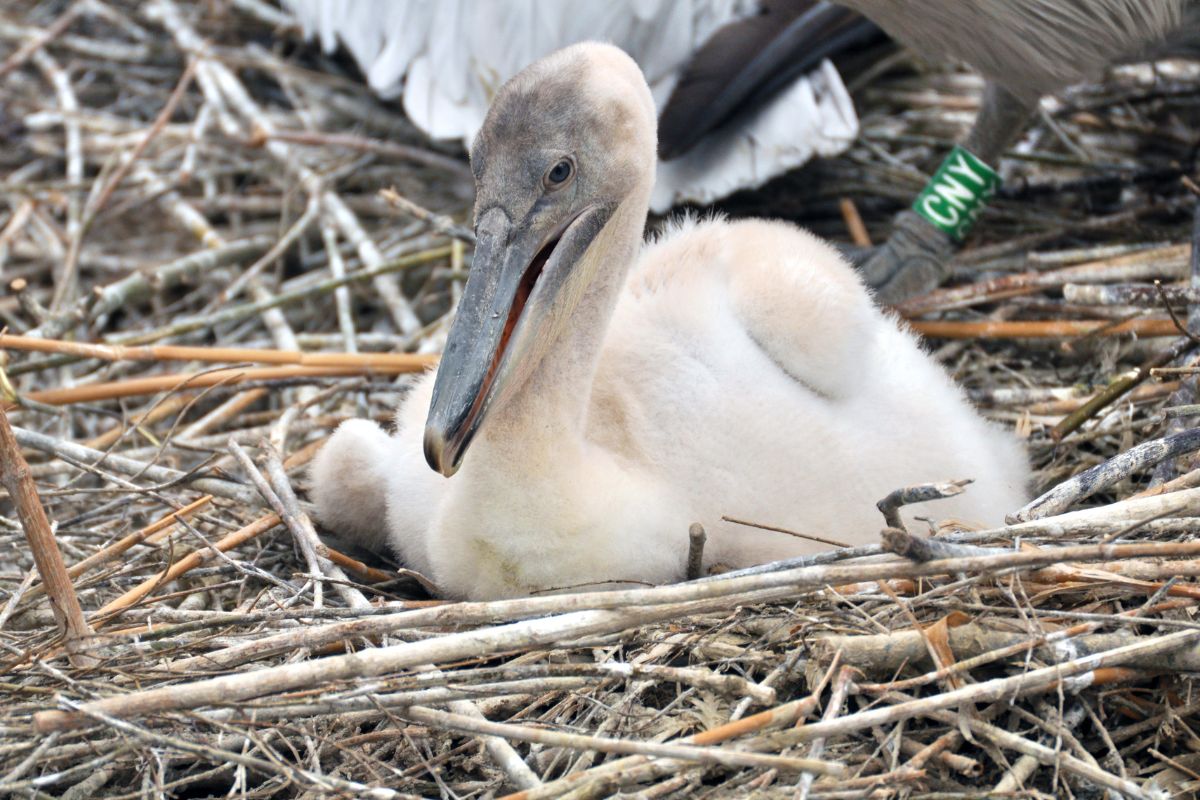
Baby pelicans are fascinating creatures, but did you know there are several species? The offspring of each species differ in many ways. Read on to learn about the following species:
- American White Pelicans
- Australian Pelicans
- Brown Pelicans
- Great White Pelicans
- Peruvian Pelicans
- Spot-billed Pelicans
Contents
The Appearance of Baby Pelicans
Baby pelicans are very small and underdeveloped when they first hatch. Initially, they are naked and barely able to open their eyes or hold their heads up.
As their feathers come in, the colors are duller than those of adults, and their markings are less distinctive. Even their bills are more muted in color.
Babies have an egg tooth at the tip of their bills, which allows them to break free of the egg. They are also born with a pouch.
American White Pelicans
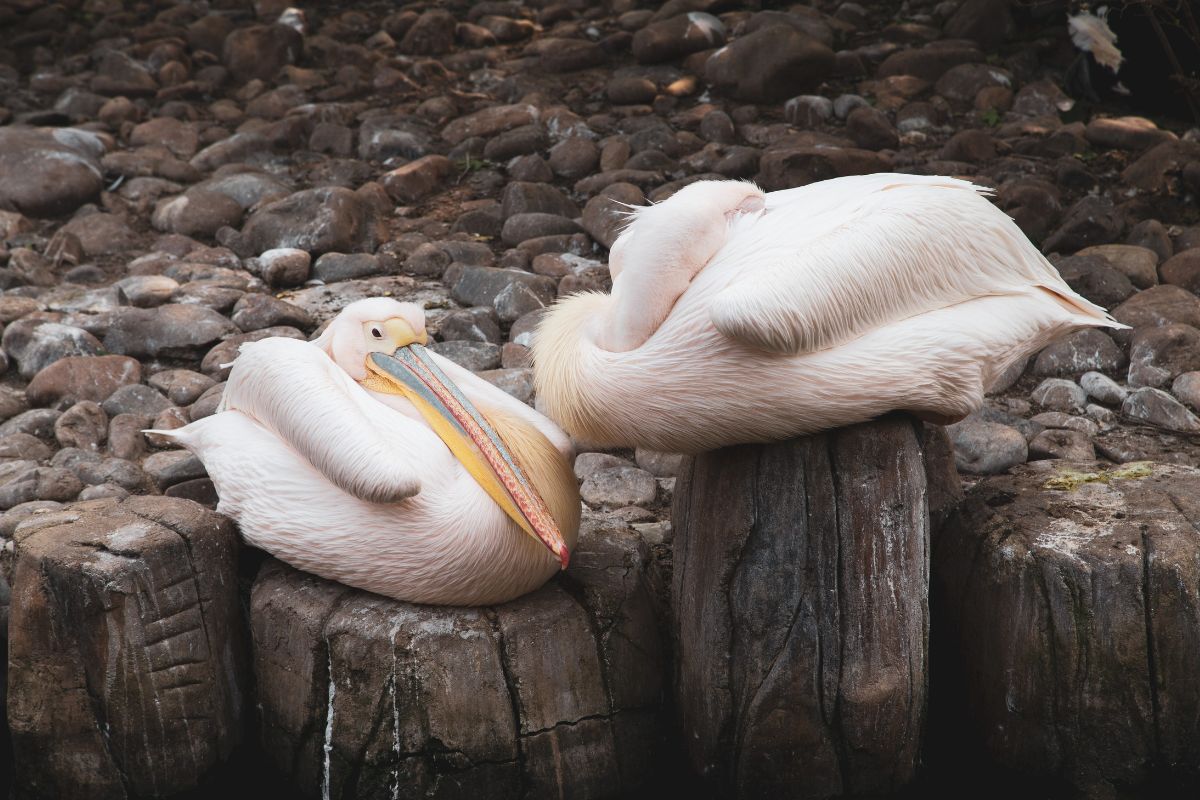
After hatching, American White Pelicans are pink. Within two weeks, however, they become gray or black.
These babies weigh 3.9 ounces when they hatch.
Australian Pelicans
Hatchling Australian Pelicans are both blind and naked.
Brown Pelicans
A baby brown pelican is pink until its feathers begin to grow. At that point, it turns gray-brown along its head and neck, but its stomach and breast are almost white. As it ages, its body turns gray-brown while its head and neck lighten.
Hatchlings belonging to this species weigh around 2.6 ounces.
Great White Pelicans
Most baby pelicans grow white soft down feathers, but Great White Pelicans grow brown feathers. Although they are naked upon hatching, the brown down feathers develop quickly.
Great White Pelicans are the largest of all pelicans, and their chicks weigh 5.3 ounces.
Peruvian Pelicans
Peruvian Pelicans are gray at first. Their down feathers come in around ten days of age.
Spot-billed Pelicans
Spot-billed Pelicans are naked after hatching, and their skin is light. The layer of white down feathers grows rapidly, and the birds turn brown when they become juveniles. Around six months of age, they show signs of bill spots.
Birth of Baby Pelicans
Baby pelicans can be born during any season based on their species.
American White Pelicans lay their eggs within a small window from March to May. Australian Pelicans usually breed during winter and early spring, while Brown Pelicans can lay eggs throughout most of the year, between December and September.
Great White Pelicans have the most flexibility and can lay eggs any time of year, while Peruvian Pelicans typically breed between September and March.
Spot-billed Pelicans breed at different times based on their location. Those in Sri Lanka breed between December and April, while those in India begin breeding in October.
It can take between 29 and 36 days for pelican eggs to hatch.
Growth of Baby Pelicans
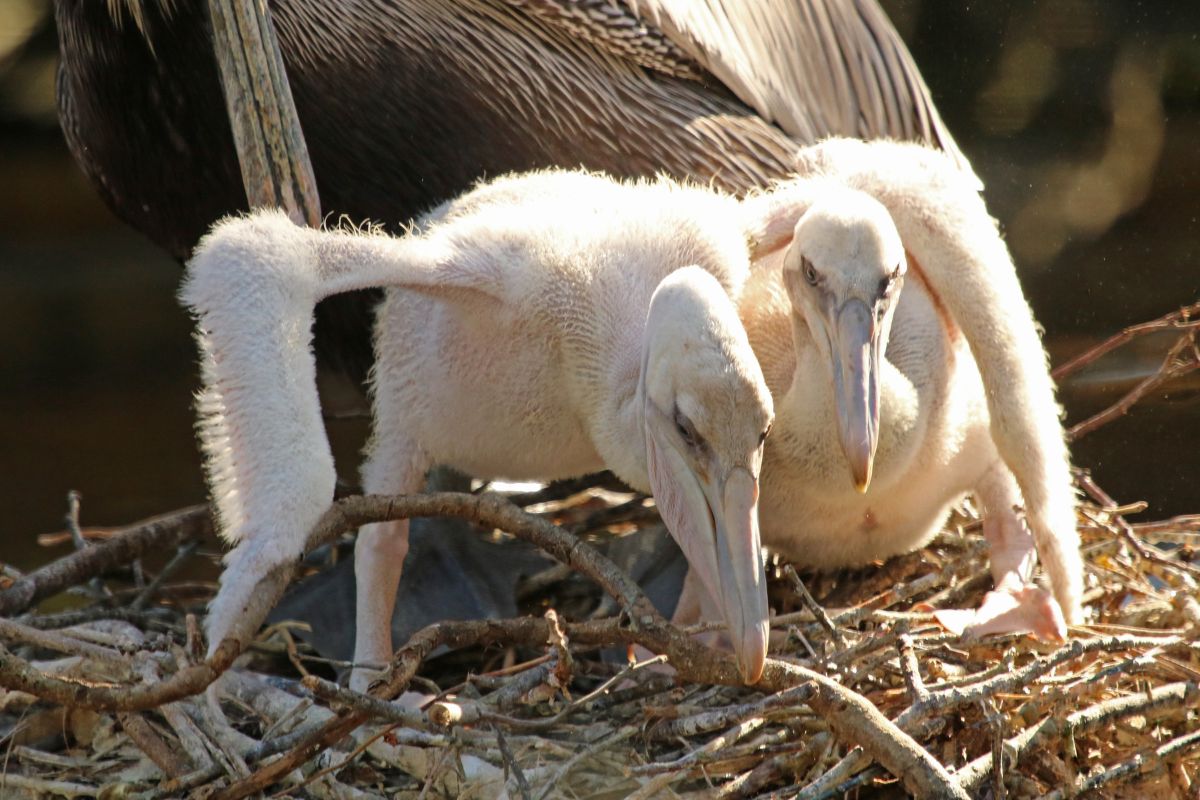
A bird’s growth is measured by the age at which it learns to fly, also known as fledging. Scientists also track when birds reach sexual maturity.
American White Pelicans
After only three to four weeks, American White Pelicans fledge, but their parents continue taking care of them for another three weeks. They reach sexual maturity around three years.
Australian Pelicans
Australian Pelicans fledge around two months after hatching. After four months, they are independent and reach sexual maturity after three to four years.
Brown Pelicans
On average, Brown Pelicans fledge at 63 days. The young then form their own groups, called pods. Between three and five years after hatching, these birds attain sexual maturity.
Great White Pelicans
Great White Pelicans fledge between 65 and 75 days after hatching. They reach sexual maturity around three or four years.
Peruvian Pelicans
Most Peruvian Pelicans fledge around 85 days of age and are considered sexually mature after three to five years.
Spot-billed Pelicans
The fledging age of Spot-billed Pelicans is between 60 and 90 days. After 12 weeks, they are independent and reach sexual maturity at about 30 months.
Diet of Baby Pelicans
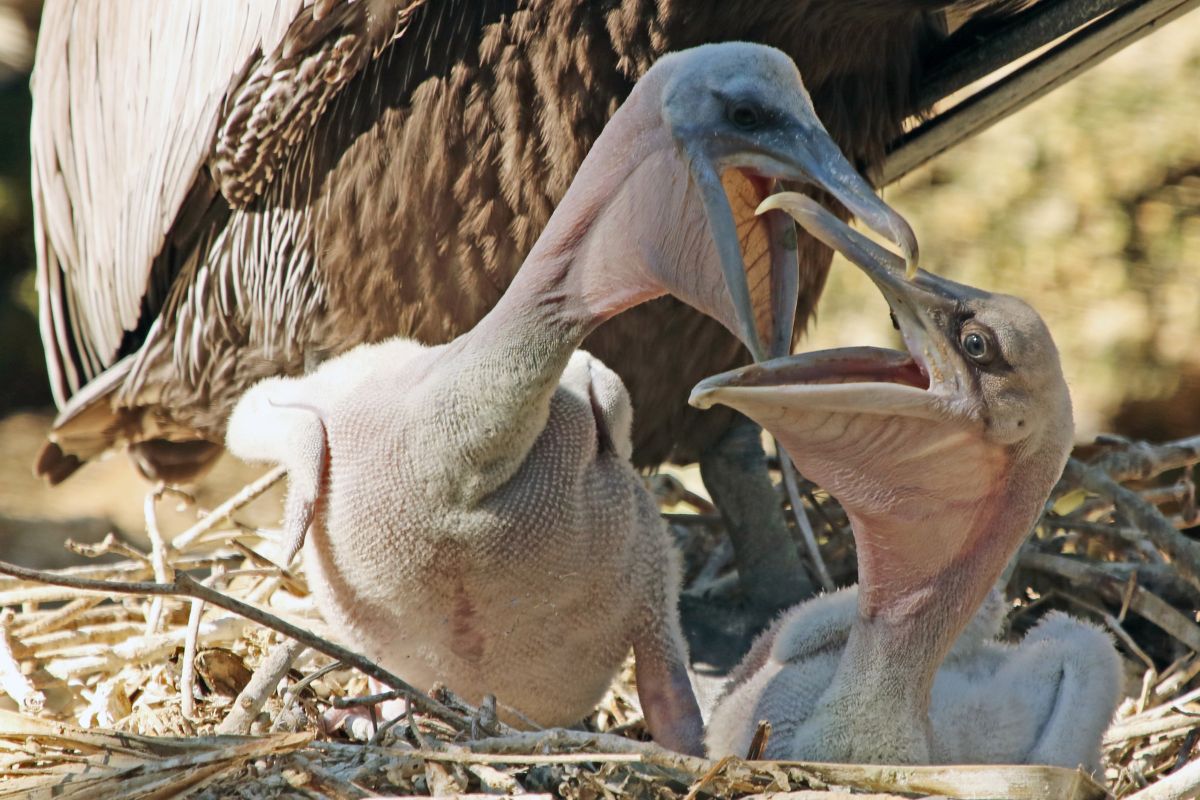
Most baby pelicans eat fish, amphibians, crustaceans, insects, and other small animals. While pelicans along the sea frequently feed on mullets, herring, sardines, and anchovies, those beside freshwater typically eat trout and minnows.
Fish provide key nutrients such as protein for growth, fatty acids for brain development, and vitamin A for ocular development.
Aside from fish, baby pelicans often eat crabs, shrimp, and squid.
How Baby Pelicans Are Fed
After hatching, baby pelicans are helpless and rely heavily on their parents. Initially, their parents must regurgitate food onto the floor of the nest. This process softens the food, allowing the babies to pick it apart.
As the babies grow, they learn to take fish out of their parents’ pouches. After only a month, they can retrieve food from their parents’ throats.
Frequently Asked Questions
There is much more to learn about baby pelicans. Continue reading to find the answers to common questions.
How many eggs do pelicans lay?
Most American White Pelicans and Great White Pelicans lay two eggs, while Brown Pelicans lay three. Peruvian Pelicans can lay two or three eggs.
Australian Pelicans show the most variety, as they may lay between one and three eggs each season. Additionally, Spot-billed Pelicans lay an average of three eggs every season, the highest average.
Unfortunately, not all eggs survive. Of the two eggs that Great White Pelicans lay, only one chick survives in most situations.
Where can I find baby pelicans?
Pelicans inhabit every continent except Antarctica. American White Pelicans breed in North America, while Great White Pelicans live in Africa.
Australian Pelicans live near water and must have access to large quantities of fish. They may live in tropical, terrestrial, saltwater, or freshwater areas.
Brown Pelicans can breed in a couple of areas, including estuaries and coastal marine habitats between Maryland and Venezuela or between California and southern Ecuador.
Peruvian Pelicans live along the west coast of South America between Lobos de Tierra Island, Peru, and Pupuya Islet, Chile.
Spot-billed Pelicans exist only in Southeast Asia and are most frequently seen in India, Sri Lanka, southern Cambodia, and Sumatra.
What Are Baby Pelicans Called?
Once they emerge from their eggs, baby pelicans are called hatchlings. As they grow, they are known as chicks, and once their flight feathers come in, they are known as juveniles.
Pelicans also have scientific names that vary by species. These are listed below.
American White Pelicans: Pelecanus erythrorhynchos
Australian Pelican: Pelecanus conspicillatus
Brown Pelican: Pelecanus occidentalis
Great White Pelican: Pelecanus onocrotalus
Peruvian Pelican: Pelecanus thagus
Spot-billed Pelican: Pelecanus philippensis
Conclusion
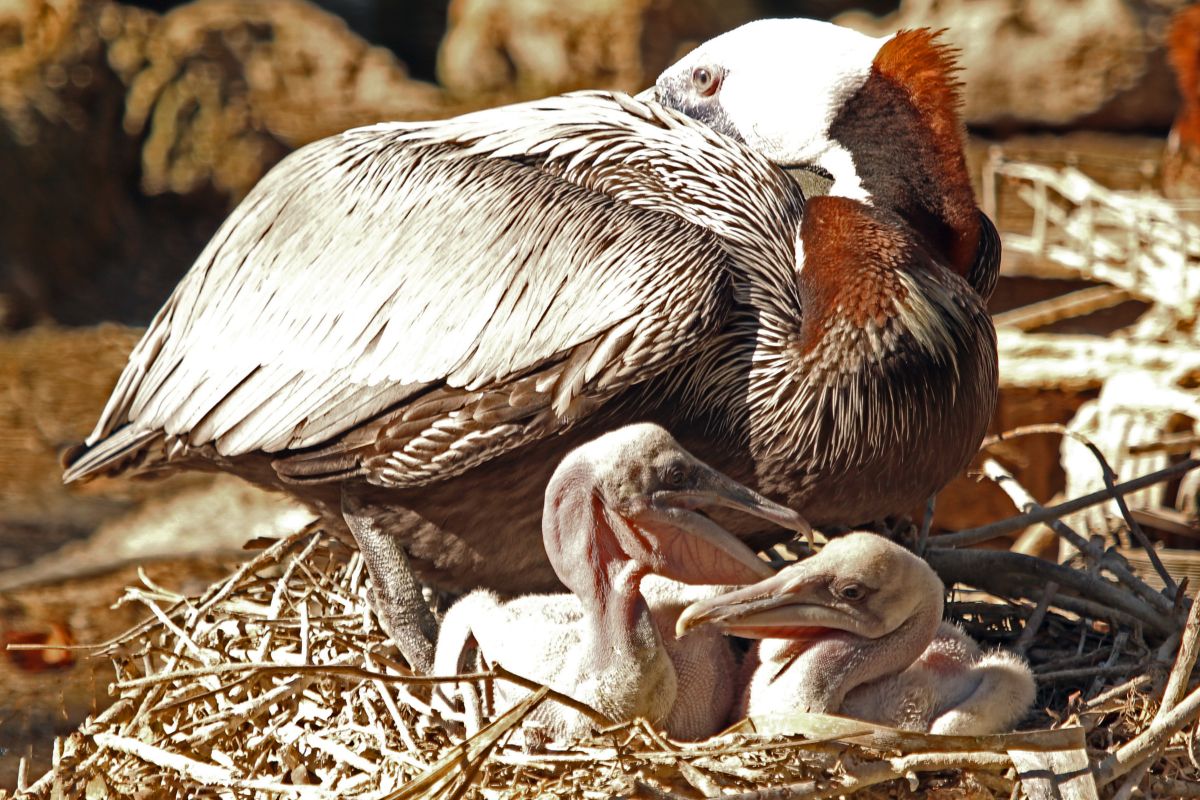
Although baby pelicans are extremely vulnerable after hatching, they quickly grow into strong, majestic creatures. They progress from eating partially-digested food from the floor of the nest to finding food themselves in only months.
Each species has distinguishable markings, but the hatchlings can be difficult to identify due to their lack of feathers and muted colors. You can typically guess which species you see based on your location.
Certain species of pelicans, like the American White Pelicans, are endangered. Now that you know all about baby pelicans, you can help spread awareness and keep these precious birds safe for generations.
